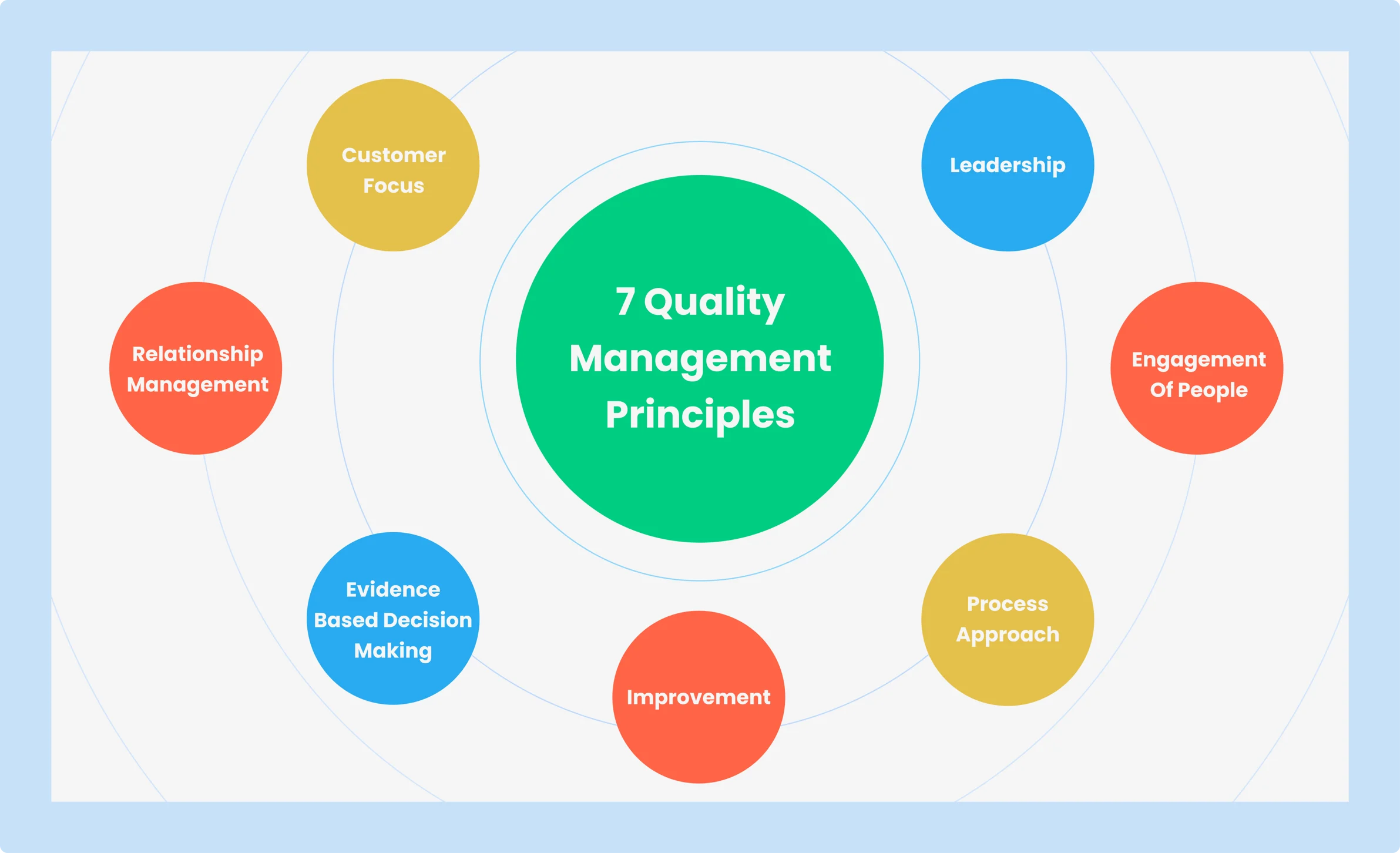Discover 7 key quality management principles for project success

As organizations strive for excellence, quality management plays a pivotal role in ensuring customer satisfaction, operational efficiency, and continuous improvement. In this blog, we explore the key principles of quality management, the benefits of implementing a quality management system (QMS), and how Rework.com, a work management platform, serves as a powerful tool for quality control, transforming your quality management efforts.
Quality Management Systems
Quality management is the systematic approach to ensuring that products, services, and processes meet or exceed customer expectations. By prioritizing quality, organizations can enhance customer satisfaction, build a positive reputation, and drive business growth.
1. Definition and Purpose of Quality Management Systems
A Quality Management System is a framework that enables organizations to establish and maintain quality objectives, implement standardized processes, and continuously improve their operations. It provides a structured approach to quality management, ensuring consistency and accountability across the organization.
2. Internationally-Recognized Frameworks
Frameworks such as ISO 9000, ISO 9001, and CMMI offer globally accepted guidelines for QMS implementation. These frameworks provide best practices, standardized processes, and certification options, demonstrating an organization's dedication to quality.
7 Quality Management Principles
The ISO 9001 standard is based on seven quality management principles that serve as the foundation for a successful Quality Management System (QMS):

1. Customer Focus
Understanding Customer Expectations: Organizations must prioritize understanding and meeting customer needs and expectations to deliver products and services that add value.
Enhancing Customer Satisfaction: By exceeding customer expectations and consistently delivering high-quality products and services, organizations can foster customer loyalty and satisfaction.
2. Leadership
Setting Clear Goals and Objectives: Effective leadership involves setting clear goals, objectives, and expectations for quality performance, guiding the organization toward its vision.
Leading by Example: Leaders must lead by example, demonstrating a commitment to quality and fostering a culture of accountability and continuous improvement throughout the organization.
3. Engagement of People
Empowering Employees: Empowering employees by providing them with the necessary authority, resources, and support enables them to take ownership of quality and contribute to organizational success.
Providing Necessary Tools and Resources: Organizations should invest in training, development, and resources to equip employees with the skills and knowledge required to excel in their roles and drive quality improvement.
4. Process Approach
Formalizing Business Processes: Adopting a systematic approach to managing processes ensures consistency, efficiency, and effectiveness in delivering products and services.
Streamlining Operations: By identifying and eliminating inefficiencies and bottlenecks in processes, organizations can optimize operations and enhance overall performance.
5. Continuous Improvement
Iterative Evaluation and Adjustment: Embracing a mindset of continuous improvement involves regularly evaluating performance, identifying opportunities for enhancement, and implementing changes to drive progress.
Pursuing Ongoing Enhancement: Organizations should foster a culture of innovation and learning, encouraging employees to seek new ways to improve processes, products, and services.
6. Evidence-Based Decision Making
Leveraging Data and Insights: Making informed decisions based on data and evidence enables organizations to identify trends, patterns, and opportunities for improvement, mitigating risks and maximizing outcomes.
Informed Decision-Making Processes: By integrating data-driven insights into decision-making processes, organizations can minimize subjectivity and bias, leading to more effective and strategic decision-making.
7. Relationship Management
Cultivating and Enhancing Relationships: Building strong relationships with customers, suppliers, and stakeholders fosters collaboration, trust, and mutual understanding, driving shared success.
Partnering for Mutual Benefit: Collaborating with partners and stakeholders to co-create value and achieve common goals enhances competitiveness and strengthens the organization's position in the marketplace.
By embracing these principles, organizations can create a culture of quality, innovation, and customer-centricity, driving sustainable growth and success.
Strategies for Effective Implementation Quality Management Practices
To effectively implement quality management practices, consider the following strategies:
1. Planning and Goal Setting
Successful implementation begins with clear planning and goal setting. Define measurable objectives aligned with quality management principles, ensuring they are specific, achievable, relevant, and time-bound (S.M.A.R.T.). Develop a roadmap outlining the steps, timelines, and responsibilities for achieving these objectives.
2. Training and Development Initiatives
Empower employees with the knowledge, skills, and resources necessary to embrace quality management principles. Implement comprehensive training programs that educate employees on quality concepts, methodologies, and tools. Foster a culture of learning and continuous improvement, encouraging employees to actively participate in skill development initiatives.
3. Monitoring and Evaluation Processes
Establish robust monitoring and evaluation processes to track progress, identify areas for improvement, and measure the effectiveness of quality management initiatives. Regularly monitor and evaluate performance against established KPIs, leveraging quality control tools such as Rework.com to streamline this process, enabling you to track progress, identify improvement areas, and ensure compliance with greater efficiency and accuracy.

Conclusion
In conclusion, embracing 7 quality management principles is crucial for organizations seeking to thrive in today's competitive market. As businesses seek innovative solutions to optimize operations, Rework.com offers more than just a work management platform; it's a comprehensive solution designed to streamline operations and amplify quality initiatives.
Rework.com empowers you with:
Centralized Documentation: Securely store and easily access quality policies, procedures, and manuals for consistent application across the organization.
Collaborative Workflows: Foster seamless teamwork and knowledge sharing by facilitating efficient collaboration on quality improvement initiatives.
Real-time Insights: Gain valuable data-driven insights into your quality performance metrics, enabling proactive identification and resolution of issues.
Join the ranks of leading organizations worldwide who have chosen Rework to elevate their quality management practices and unlock their full potential.
FAQ Section
Frequently Asked Questions about Quality Management Principles

Tara Minh
Operation Enthusiast
On this page
- Quality Management Systems
- 7 Quality Management Principles
- 1. Customer Focus
- 2. Leadership
- 3. Engagement of People
- 4. Process Approach
- 5. Continuous Improvement
- 6. Evidence-Based Decision Making
- 7. Relationship Management
- Strategies for Effective Implementation Quality Management Practices
- 1. Planning and Goal Setting
- 2. Training and Development Initiatives
- 3. Monitoring and Evaluation Processes
- Conclusion
- FAQ Section